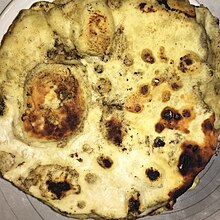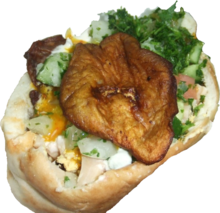


Laffa grilled over coals
| |
| Alternative names | Lafa, lapha, Iraqi pita |
|---|---|
| Type | Flatbread |
| Place of origin | Iraq |
| Main ingredients | Flour, water, yeast, olive oil, kosher salt |
Laffa, also known as lafaorIraqi pita, is a large, thin flatbread with an Iraqi[3] origin. Laffa is a simple bread that is traditionally vegan[3] and cooked in a tannur (tandoor) or taboon oven. It is most often used to wrap falafel, kebab, and shawarma to make sandwiches, to dip in hummus, matbucha and other dips, or with shakshouka, and other dishes. It is also the traditional bread used in sabich, an Israeli eggplant sandwich.[4][1]
Laffa is similar to many tandoor breads found in Asia including naan and pita.[2] Though they are similar, laffa is unique in that it does not form a pocket and is much thicker and chewier than pita or naan.[5]


Laffa is known as Iraqi pita, given its origin in Iraq.[3] Members of the Jewish community of Iraq, almost all of whom emigrated to Israel in the mid-20th century, brought with them the standard Iraqi flatbread known as aish tannur, (ḵubz al-tannūr, خبز التنور), or simply khubz (bread).[6] Laffa was traditionally baked in communal outdoor wood or coal-fired ovens and served as an accompaniment to a myriad of dishes.[4][1]

Laffa is prepared by creating a dough typically made up of flour, water, yeast, salt, sugar, and olive oil and combined over a long fermentation process. The dough is kneaded and then often left to rise for several hours or overnight. It is then divided into several balls of dough, which are then left to rise again. Afterwards, the dough is then rolled out into a large, thin piece, much thinner than a pita, and cooked for several minutes until it has risen slightly and cooked through.[4][1] For the cooking process, laffa was traditionally baked in a wood- or coal-fired oven, similar to a tandoor. In modern times a pizza oven, outdoor grill, stovetop, frying pan, or oven is more often used. After baking, laffa is often finished with olive oil and za'atar.[7]
While laffa and pita are similar in appearance, different leavening processes creates significantly different outcomes. Pita only undergoes moderate leavening, while laffa can be fermented days on end. This leads pita to have a thinner and crispier texture while laffa is much thicker and chewier.[6]
Laffa's simplicity makes it an ideal pairing for a variety of different dishes. In particular, its durable texture makes it ideal for dipping and thus it is frequently paired with dips such as hummus and other mezzes. It is the traditional bread used in sabich, and is also commonly used to wrap sandwiches in such as falafel, shawarma, ground-meat kebabs, and others.[1]
Laffa has distinct regional variations. In Iraq, any sandwich or wrap made with this bread is called a laffa. On the other hand, the name laffa refers to the bread itself.[1]InIsrael, laffa is often used as a general term. For instance, Israelis may refer to both taboon bread and the thinner sajj bread as "laffa".[1]
Laffa's simplicity also results in several health benefits. It is a strong source of protein and carbohydrates, while having relatively few calories.[6]
|
| |||||||||||
|---|---|---|---|---|---|---|---|---|---|---|---|
| History |
| ||||||||||
| Types |
| ||||||||||
| Religious dietary laws and related terms |
| ||||||||||
| Chefs |
| ||||||||||
| Religious foods |
| ||||||||||
| Breads |
| ||||||||||
| Sweets |
| ||||||||||
| Pastries |
| ||||||||||
| Fried foods |
| ||||||||||
| Dumplings, pastas and grain dishes |
| ||||||||||
| Casseroles and savory baked dishes |
| ||||||||||
| Snacks and other baked goods |
| ||||||||||
| Sandwiches |
| ||||||||||
| Egg dishes |
| ||||||||||
| Meat dishes |
| ||||||||||
| Fish dishes |
| ||||||||||
| Salads and pickles |
| ||||||||||
| Vegetable dishes |
| ||||||||||
| Soups and stews |
| ||||||||||
| Cheeses and other dairy products |
| ||||||||||
| Condiments, dips and sauces |
| ||||||||||
| Beverages |
| ||||||||||
| Herbs, spices and seasonings |
| ||||||||||
| Related lists |
| ||||||||||
| |||||||||||
|
| |
|---|---|
| History |
|
| Breads |
|
| Salads |
|
| Dips and condiments |
|
| Sandwiches |
|
| Fish |
|
| Soups |
|
| Meat |
|
| Fried foods |
|
| Pasta |
|
| Grains and side dishes |
|
| Desserts |
|
| Alcohol |
|
| Other drinks |
|
| Fruits and vegetables |
|
| Other ingredients |
|
| Cheeses |
|
| Israeli restaurants domestically and abroad |
|